
Station Name: LONGTON BRIDGE [Source:Tony Graham &
Paul Wright]
bridge_old8.jpg) Longton Bridge station looking east from the down (Preston-bound) platform in the late 19th century. A train bound for Southport Central is arriving at the up platform. In the middle distance, to the left, the station’s goods yard with its stone goods shed can be seen. The chimneys to the right served the Bentley brick, tile and pottery works.
 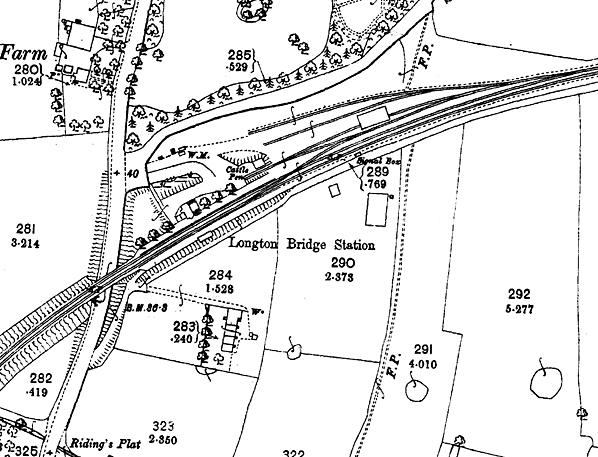 1892 1:2,500 OS map from the period before the jam factory and brickworks had opened and sidings had been laid to serve them.
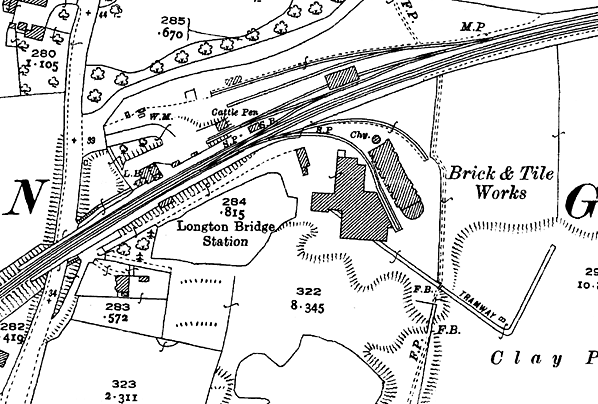 1931 1:2,500 OS map. The station had all of its original facilities and sidings that served what, by this time, had become a brick and tile works.
bridge_old13.jpg) Longton Bridge station looking east in 1939 during LMS days. At this time the station’s goods shed, seen in the distance beyond the signal box, was in situ. The station appeared to be very
tidy and well kept. Copyright photo from Stations UK bridge_old12.jpg) Longton Bridge station looking east c.1950. A Southport Chapel Street service was arriving at the up platform where a group of school children was waiting; this suggests that the picture was taken in the afternoon, and that they were returning home from school. The picture was taken from the down (Preston-bound) platform beyond, with the station signal box at its north end. The goods yard sidings can be seen beyond the box, but the goods shed had been demolished by this time.
Copyright photo from Stations UK bridge_old13.jpg) Longton Bridge station looking east from its west end in 1963. The curious construction of the platforms at this end is clearly illustrated. Timber sections followed the stone sections and ran up to the Liverpool Road bridge. On the bridge itself the platforms reverted to having paved edges with a metalled surface. The platforms appear very long, but by this date no regular services required such length.
Copyright photo from Stations UK bridge_old4.jpg) On 8 August 1964 a British Railways Class 2MT locomotive No. 78041 departs from Longton Bridge station on the 5:09 pm Southport Chapel Street to Preston service. Almost the entire length of the down (Preston-bound) platform is shown. 78041 is a Riddles development of the Ivatt 'Mickey Mouse' Class 2, 2-6-0. Delivered new to 27A, Bank Hall, it had enjoyed a working life of just 12 years when it was withdrawn from Patricroft in May 1967; it was cut up in November the same year.
bridge_old7.jpg)
Looking south-west towards Southport from Hoole station's down (Preston -bound) platform in August 1964 as the same train (seen above) prepares to depart for Southport Chapel Street. The station gardens appear well tended. 42675 was built by the LMS in 1945 at Derby Works. This Fairburn-designed 4P, 2-6-4-tank was delivered new to 5D, Stoke shed. After allocations to 5F Uttoxeter, 9E Trafford Park and 8P Wigan Central (L&Y), it was allocated to 27C, Southport, from where it was withdrawn on 18.9.1965 and cut up at Wards in November of the same year.
bridge_old11.jpg) The main station building at Longton Bridge on Sunday 6 September 1964. By this time no regular scheduled passenger services called at the station on Sundays and the next day the station would be closed completely. The family seen in the picture may have come along to view the last trains passing through the station the 6th being the last day of passenger services between Southport and Preston.
bridge_old5.jpg) Once a common sight, but by 1964 a very rare visitor to the WLR, is one of the last Fowler 2-6-4 Class 4 tanks, No. 42369, seen here making a very rousing departure from Longton Bridge on 5th September at the head of the 12.18 pm Saturday only Southport - Preston service. 42369 was built at Derby Works and entered service as 2369 on 11.9.1929. Passing to BR in 1948 at 9C, Macclesfield shed, it received the number 42639 before moving to 9A Longsight in September 1958. It was allocated to a further 10 sheds in the North West until its final allocation at 8F, Springs Branch (Wigan) on 8.5.1965 from where it was withdrawn a week later on 17.5.1965 and cut up by the end of that month a
t Central Wagon Co, Wigan. Photo by Alan Castle bridge1.jpg) Looking east from the down (Preston-bound) platform at Longton Bridge station in May 1968. Although the track had gone by this time the stations platform's and buildings were still intact although derelict. Also still in place was one of the chimneys from the former Bentley brick work complex that had been served by its own sidings.
Photo by Tony Graham bridge2.jpg) Looking north-east at the site of Longton Bridge station in August 1984. The station had been completely demolished, but mounds to the left and right were degraded remains of the platforms.
Photo by John Mann bridge5.jpg) The western end of the up (Southport-bound) platform at Longton Bridge station in July 2011.
Photo by Paul Wright  Home
Page Home
Page
|
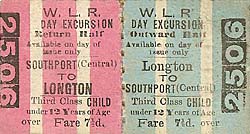
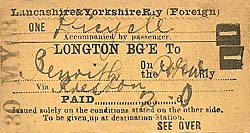

3.jpg)
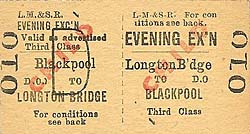
6.jpg)
.gif)
7.jpg)
8.jpg)